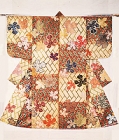Japanese Gallery (Honkan) Room 9
February 19, 2008 (Tue) - April 20, 2008 (Sun)
Ebira (The Quiver) was one of the most popular Noh plays during the Edo period (1600-1868) when Noh became the official ceremonial theatre art of the warrior class. The hero of the play is the ghost of Kajiwara Genta Kagesue, a warrior known for his distinguished services in the war between the Genji (Minamoto) and Heike (Taira) clans. The story of the play is as follows:
A traveling priest, dressed humbly in a mizugoromo coat and a sumiboshi hat, arrives at the ancient battlefield of Ikuta in Suma (in modern day Hyogo Prefecture) to find a man wearing a suo (a garment for the warrior class) staring at the plum blossoms. When the priest questions him about the significance of these blossoms, the man explains that this was the site of a battle between the armies of Genji and Heike. The Heike army numbered 100,000 men, while the Genji army was only 60,000, however among them was a brave, young warrior with a poetic soul, who was attracted to these plum blossoms and broke off a branch to put in his quiver before going into battle. The man concludes that because of this story, he calls the tree "The Plum Tree of The Quiver".
The priest asks the man for a night's lodging, but he answers that he is the ghost of the warrior who fought with the branch in his quiver and possesses the tree, then he disappears leaving the astounded priest. A local inhabitant in kataginu (a sleeveless jacket) and hanbakama (ankle length trousers) approaches and tells the priest about the warrior Kagesue's remarkable achievements in the battle of Ikuta. The ghost of Kagesue then reappears, now clad in armor and wearing a mask called a Heita, used for the role of a young warrior. A warrior on the Noh stage wears a happi coat made of colorful fabrics in katanugi style (bearing one shoulder) and a pair of hangire trousers, which symbolize armor. The ghost of the warrior dances to show how he fought with a plum branch at Ikuta, and tells of the savagery behind glorious battles. As the warrior disappears, the priest wakes up to find that the ghost was only in his dream.

